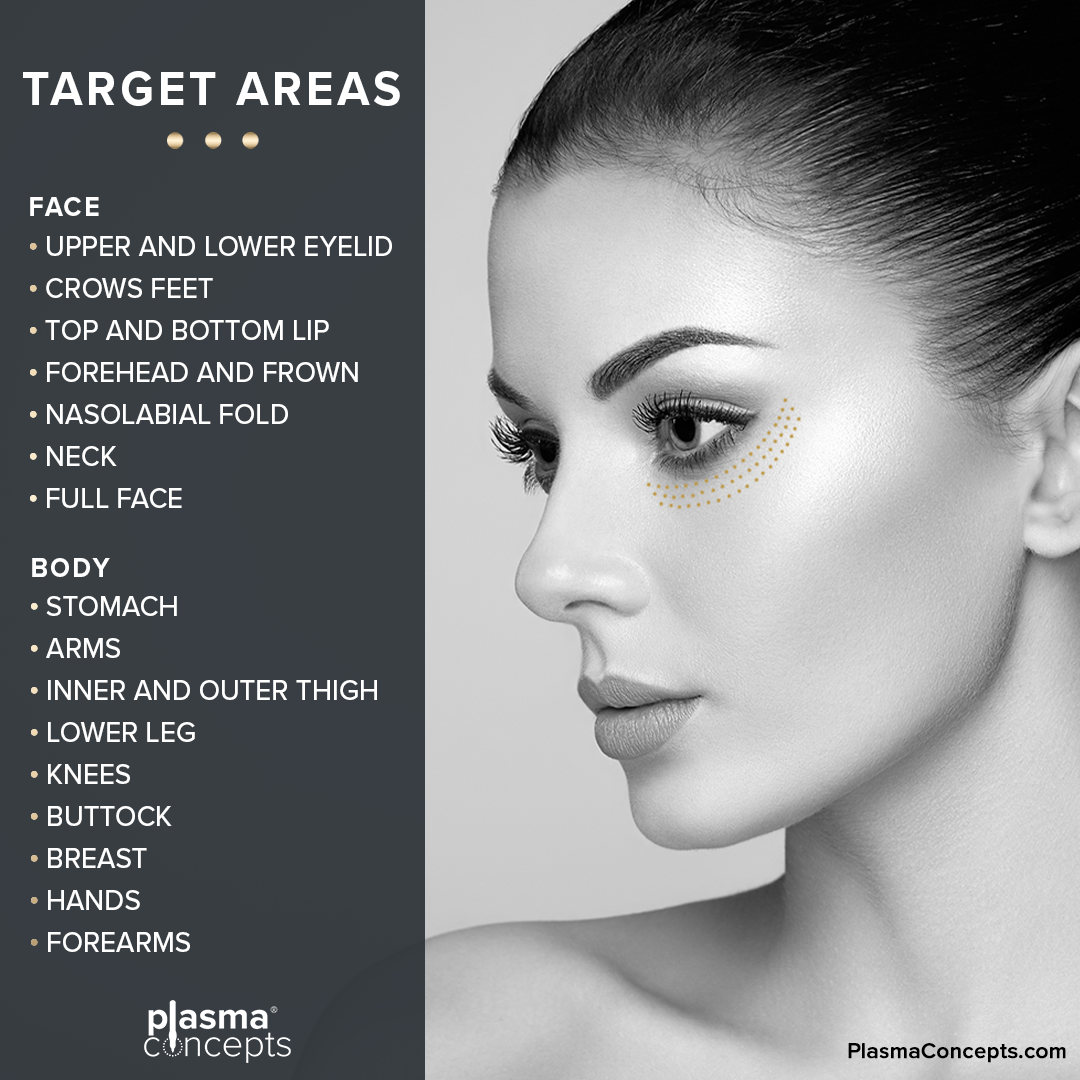
The Plasma Pen is a groundbreaking non-surgical, non-invasive skin treatment. Plasma Pen sessions (also called “fibroblast” therapy) reduce the appearance of wrinkles and rejuvenate dull and sagging skin by stimulating collagen production.
Plasma Pen technology has been approved by the FDA, and in the hands of a skilled and trained esthetician, such as Axelle Mesmacque at French Radiance in Arizona, a Plasma Pen can be the key to a youthful, contoured look at any age.
What Is a Plasma Pen?
The Plasma Pen is a high-end, high-tech skin treatment tool from Plasma Concepts.

How Does It Work?
Plasma Pen’s unique technology operates on electricity, which is converted to gaseous diatomic nitrogen (N2). This energized gas is applied to the skin of the face (or whatever region is being treated), which is used as an abrasive on a micro level to the epidermal layer of skin (the top or outermost layers) and also heats and stimulates the deeper layers.
The process by which a Plasma Pen works is called fibroblasting. The “blasting” part can make it sound a little intense or dangerous, but it’s actually named for fibroblasts, which are a common type of cell in your body’s connective tissue. Fibroblasts are responsible for producing collagen, and it’s by stimulating this collagen production that Plasma Pen treatment is able to fill wrinkles, tighten sagging skin, and more.
How Long Does It Take?
Plasma Pen treatment sessions typically take around an hour. Treatments for larger areas, as in the case of stretch marks or sagging arm skin, can take up to two hours and may even be split into multiple sessions.
What Is a Plasma Pen Used For?

As the human body ages, our dermal layers of skin naturally start to thin out and produce less collagen. This can cause our outward appearance to become wrinkled or saggy. Fibroblasting therapy can counteract this natural process and get collagen production jump-started again to halt or even reverse the signs of aging.
The collagen-boosting effects of Plasma Pen treatment make it a great choice for pursuing a wide range of esthetic goals and treating a variety of dermatological conditions.
Some of the most common applications for Plasma Pen treatment are:
- Sagging or excess skin. Most often around the face, jowls, or neck, but Plasma Pen treatment can be used on pretty much any part of the body that has loose skin from aging or weight loss.
- Eyes. Puffiness, hooded lids, and drooping “bags” can all be successfully treated with Plasma Pen fibroblasting. It may even provide a viable alternative to eye lift surgery in some cases.
- Wrinkles and fine lines. Including crow’s feet, accordion lines, furrows, laugh lines, marionette lines, and creased brows.
- Scars. Including acne scars and stretch marks.
- Milia. Dead cells beneath the epidermis that appear in the form of white bumps.
- Spider veins. Twisted blood vessels that can be seen through the skin.
The Plasma Pen’s innovative fibroblasting treatment can be used for all manner of skin tightening, smoothing, rejuvenation, and anti-aging efforts. Plasma Pen treatment is a great alternative for those not interested in costly, invasive surgeries such as eye lifts, neck lifts, and brow lifts.
Are the Results of Plasma Pen Treatment Permanent?
Like most non-surgical esthetic procedures, the effects of your Plasma Pen treatment may diminish with time or require additional treatments to maintain. Just how much time? The answer may be surprising to people who are accustomed to visiting their esthetician for fillers or injections multiple times per year.
A successful Plasma Pen treatment stimulates collagen production to such an extent that the results are noticeable for multiple years. The benefits of fibroblasting typically last at least three or four years, and sometimes even longer than that!

Plasma Pen With Other Treatments
For the best and longest-lasting results, your esthetician might recommend combining Plasma Pen treatment with other procedures, such as wrinkle relaxing injections, dermal fillers, chemical peels, or topical agents.
Does Plasma Pen Treatment Hurt?
Plasma Pen patients experience very little pain and minimal disruption to their day-to-day routines or social lives.
Most people who undergo Plasma Pen treatment report only very mild discomfort during the procedure itself. Your esthetician will begin the Plasma Pen treatment process by using prescription-grade topical anesthetics to numb the target area for the duration of the procedure. Numbing agents may be reapplied between passes as needed. Many patients experience no pain whatsoever.
Plasma Pen Treatment Recovery
Although Plasma Pen treatment is abrasive on a micro level, causing small, burn-like injuries around the treated site, these injuries are typically quite superficial and result in only minor discoloration and swelling. The healing from Plasma Pen treatment can be described as similar to an extremely small sunburn or tattoo, and typically clears up naturally within a few days of treatment.
Bruising, swelling, and overall discomfort can sometimes persist beyond the healing period, but it’s very rare for these symptoms to last any more than five to seven days, and can typically be treated with common over-the-counter medications.
The dermis layers of the skin will continue to heal “behind the scenes” for many weeks after the procedure is completed. It is during this extended healing process that the skin begins to tighten, ramp up production of additional collagen, and create the desired results. That’s why the treated area might very well look better twelve weeks after your treatment than one week, and the results will remain noticeable for literally years after that.
Is It Safe?
Fibroblast skin tightening technology is FDA-approved and considered safe. Plasma Pen sessions stimulate the body’s own natural regenerative abilities to refresh and resurface your skin without the need for additional chemicals or medicines. Plasma Pen fibroblasting is a low-risk procedure that has been performed thousands of times for satisfied clients all around the world. It requires no injections, incisions, or direct contact with the skin from any implement.
That being said, there are a few instances where a patient might want to avoid Plasma Pen treatment, or discuss it carefully with their primary physician:
- Pregnant or breastfeeding
- Metal implements or medical appliances near the treatment area
- Pacemakers or serious heart conditions
- Diabetes
- Epilepsy
- Cancer or autoimmune conditions that might hinder normal healing processes
- Darker skin tones may not respond to Plasma Pen treatment as well as lighter skin tones
Before any Plasma Pen work takes place, you and your provider should complete a comprehensive health screening to make sure fibroblasting therapy is a safe and effective choice for your situation.
How Much Does Plasma Pen Treatment Cost?
The cost of Plasma Pen treatment varies depending on what sort of treatment you’re seeking, how large of an area you need treated, and how many sessions are required. Targeting a specific wrinkle on one part of your face may be a quick procedure that can be done for a few hundred dollars. Meanwhile a full neck lift using Plasma Pen technology can cost over $1,000.
It is not necessarily cheap to get top-notch Plasma Pen work from a trained and experienced provider, but when compared to the financial and physical cost of cosmetic surgery, Plasma Pen fibroblasting is an excellent value.
For exact prices on specific Plasma Pen procedures, you should contact a qualified medical spa facility with Plasma Pen capabilities, such as French Radiance Esthetics in Arizona.
Plasma Pen Aftercare Procedures

The healing process in the dermis layer of your skin will continue for many weeks after you leave the esthetician’s office. Your care provider will go over detailed aftercare instructions that apply to your specific treatment, but in general here are some things you should expect to be responsible for after your Plasma Pen session:
- Keep the treated area dry until scabs have fully healed.
- Allow scabs to heal naturally, do not pick or rub at them.
- Avoid using makeup (or any other skin products not explicitly recommended by your treatment provider) on the treated area.
- Minimize your exposure to UV rays by staying indoors, keeping the treated area covered, and/or using a broad-spectrum sunscreen.
- Do not use abrasive or exfoliant skin products for up to eight weeks after treatment.
Plasma Pen vs. Microneedling
If you’re looking into cutting-edge skin treatments, you might already be aware of microneedling, another popular option for smoother, more evenly toned skin. Microneedling involves an array of twelve or more acupuncture needles being used to directly stimulate collagen production about 2.5 mm deep into the skin’s middle dermis layer.
Microneedling is entirely distinct from Plasma Pen therapy in its method of action, although there is a lot of overlap in what the two processes may be used to treat.
From the consumer standpoint, there are several key differences potential clients should be aware of.
- Targeting. While both treatments are performed using a pen-like tool, microneedling affects a broader area around the treatment site, while the Plasma Pen offers pen-like precision to target specific problem areas.
- Contact. Microneedling works on the principles of acupuncture, meaning it is actually piercing the skin with very small needles to create “microchannels” that aid in collagen stimulation and create a pathway for other skincare products to be applied to the dermis. Plasma Pen treatment, in contrast, involves no direct contact with the skin.
- Scabbing and swelling. Microneedling involves a series of tiny, pin-prick jabs that can result in tender and swollen skin in some patients for about a day afterwards. The heat and ionization from the Plasma Pen’s fibroblasting process results in superficial burn-like injuries around the treatment site that can be expected to scab for a few days.
- Longevity of results. Successful microneedling can create results that remain noticeable for up to six months, while the results of Plasma Pen treatment can last several years.
Microneedling and Platelet-Rich Plasma Therapy
Microneedling is often paired with Platelet-Rich Plasma (PRP) therapy. In microneedling with PRP, platelet-rich plasma derived from your own blood gets applied to the treated area rather than skin toners, medicinal compounds, or other therapeutic products. Patients who favor PRP therapy report that it reduces post-treatment swelling and redness compared to microneedling without PRP.
What Is Microneedling Used For?
Microneedling treatments are most often recommended for:
- Scarring and stretch marks
- Dark patches
- Fine lines and wrinkles
- Enlarged pores
If you feel that microneedling may be the correct treatment to help you achieve your skincare goals, contact French Radiance Esthetics to discuss your next steps. French Radiance offers microneedling sessions with or without PRP, and owner/esthetician Axelle Mesmacque can give you further guidance as to whether microneedling or Plasma Pen therapy is the best choice for you.

French Radiance Esthetics Has Plasma Pen Treatment Available Now
If you’re ready to take the next step and schedule your non-surgical Plasma Pen treatment, contact French Radiance Esthetics today. In addition to cutting edge Plasma Pen treatments, French Radiance also offers a variety of medical spa treatments including neuromodulators (Botox), fill-ers (Juvederm), microneedling with and without PRP, high-end skin care products, and a full range of laser services from hair removal to scar treatment.